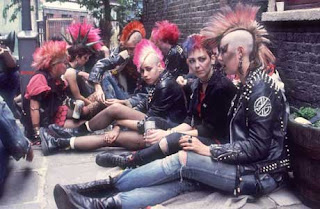Chavs
Brightly coloured sports clothing
Brands worn include Adidas Reebok Nike
Big dangly hooped earings
Low intelligence
Most are ill mannered
Think they're 'hard' but really not
Hang around in packs of 10 by fast food places
Teenage pregnancies
Go against society and cause anarchy
Values of subculture:
- Conformity and rebellion
- Capitalism and consumerism
- 'Tribal' rivalry
- Traditional or 'neophile' (a person who loves novelty, one who likes trends; person who can accept the future enthusiastically and enjoys changes and evolution)
- Ideology in 1950s and 1960s- peace, rebellion against parents, radicalism- reactions against the post war
Or that adults can appear to conform for most of the working week, but re-enter the subculture at specific time (weekend, festivals etc.)
In 21st century the 'dominant meaning systems' (that define the mainstream) are crumbling.
"There is no mainstream now. There are many streams" Mainstream is in perpetual flux, rapaciously absorbing alternative culture as such a fast rate that the notion of a mainstream becomes obsolete.
So if there is no mainstream then there is nothing for the teens to react against- instead they are driven by other motives; and these must be understood on their own terms, individual terms.
1950's Teddies (teds/ teddy boys)
Introduction of Rock n Roll (bill haley and the comets)
"Kids heard the sound of Bill haley and were blown away by it- it provided kids with the tools to set themselves apart from the older generation"
1960's Mods
Uniform continuous revolved.
Bands such as the who and small faces had changed musical style and no longer considered themselves as mods.
They were getting into marriage had no time for youthful past times.
1960's Skinheads
Among working class youths, named for shaven heads. Greatly influenced from other subcultures such as west indian and british mods.
Attitudes by race and politics- Many are apolitical - Range from clean cut to less strict punk and hardcore influences.
Early 70's Punks
Cenetered around listening to recordings or live concerts of a loud, aggressive genre to rock music called punk rock.
Ideologies concerned with individual freedom. Anti- authoritarianism, non-conformity, direct action.
The cultural revolution 1950's and 60's
The war had just ended. With this came freedom and old social cultural structures began to be challenged, especially by the young.
- Rationing was coming to an end
- American way of life- key aspiration - Commercial TV
- Cheap colour magazines- luxary commodities
- World wide economic boom
- Labour was defeated by conservatives. Election slogan 'Set the people free'
- Youth given more freedom through deregulation
America and hollywood influenced Britain.
To the average Briton it offered a rich and desirable future.
Cultural imperialism- Cultural imperialism is the practice of promoting, distinguishing, separating, or artificially injecting the culture of on society into another.
Before people didnt have televisions, refrigerators, now they were seen as basic requirement.
Car ownership rose by 250% between 1951 and 1961- average weekly earnings rose by 34%.
Status and comfort.
Identity was based around design or fashion.
Teenagers demanded goods which would seperate them from adult.
Manufactures were happy to meet this demand, they offerered them products reflecting interest in fashion and pop music.
Higher education - helped to create an increase in social mobility
Establishment values began to be questioned
Affluence, social mobility and mass media had transformed British society.
General feeling of optimism but also a sense of uncertainty- society had become more fragmented and less predictable.




No comments:
Post a Comment